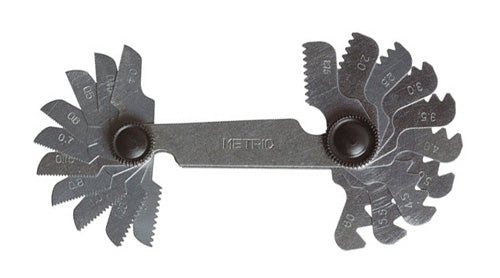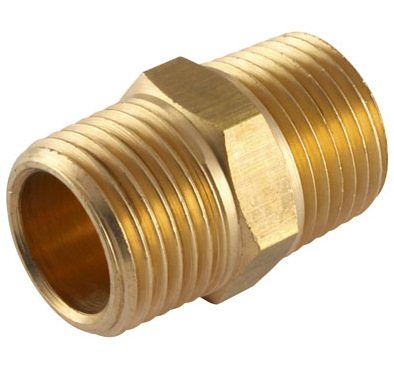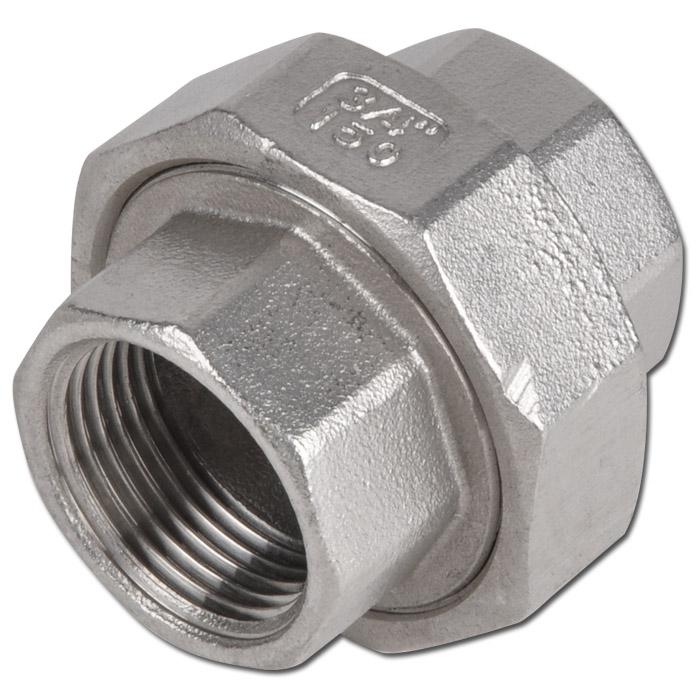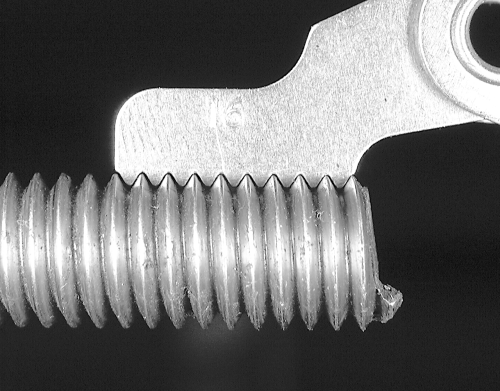Thread Type Guide: NPT, BSP, JIS, SAE, Metric – Trimantec
So you finally found the right solenoid valve to replace your broken one. You call to check stock on the item and the sales rep asks you what thread type you need. You ask, “How do I find out what thread type I need?” Fortunately, we’ve got you covered. Below you’ll find a detailed guide on how to correctly identify the most popular thread types used in industrial components. Plus, learn when it’s okay to use thread seal tape for urgent situations.
It’s important to identify the specific thread type you need in order for your equipment to function at its best. Pneumatic components such as air cylinders, valves, and air preparation units come equipped with specific port threads. For example, the pneumatic components we offer in our web store are available with either NPT, PT or G port threads. Choosing the correct thread type will ensure optimum compatibility with your equipment. At a glance, threads may look similar. But take a closer look and you’ll notice the very subtle differences that would make them incompatible with one another. For example, G threads are not compatible NPT threads because of their differing angles, shapes, and thread pitches (threads per inch).
We have compiled a simple step-by-step guide to help you identify your thread type. In addition, we’ll cover some of the most common port thread types including NPT/NPTF, BSPP (also known as G), BSPT, PT, Metric (M) and SAE. You’ll need a couple tools on hand to make the process easier, but a straight steel ruler may work as well. We also encourage you to download this Thread Identification Guide for future reference because it will certainly come in handy.
Table of Contents:
Tools You’ll Need
NPT/NPTF Thread Type Chart
BSP Thread Type Chart
PT Thread Type Chart
SAE Thread Type Chart
Metric Thread Type Chart
Thread Seal Tape and Alternative Solutions
Thread Identifying Tools You Need
Caliper –
A caliper is a useful tool that measures the outside diameter of a male thread and inside diameter of a female thread. Using a caliper will give you the most accurate and precise measurements, but a straight steel ruler is a good alternative. However, if you think you’ll be using one quite often, here’s a digital caliper we found on Amazon for a reasonable price.

Pitch Gauge –
A pitch gauge measures the threads per inch. For metric threads, this tool measures the distance between the threads. If you’re looking to buy a thread pitch gauge, Grainger has a pretty good selection.
How to Identify Different Types of Threads
Step 1 – Male Threads v. Female Threads
First, you’ll need to identify whether the thread type is male or female. Take a look at where the threads are located. If they’re on the outside of the thread, it’s a male thread. If they’re on the inside of the thread, it’s a female thread. The gender of the thread doesn’t necessarily have an impact on the functionality of the thread. It simply serves as a way to distinguish between the two connections.

Male Thread

Female Thread
Step 2 – Tapered Threads v. Parallel Threads
Next, determine if the thread is tapered or parallel. Tapered threads become narrower as they extend outward while parallel threads remain the same diameter. Sometimes this characteristic can be determined through visual inspection, but if not a caliper can come in handy. Use the caliper to measure the first, fourth, and final full thread. If the measurements are all the same, then it’s parallel. If the measurements decrease in size, then it’s tapered.
NPT/NPTF, BSPT, and Metric Tapered are examples of tapered threads. These threads create a seal through metal-to-metal wedging or slight deformation of the threads. Parallel threads will often require an o-ring or thread tape to ensure a tight seal.

Step 3 – Pitch Size
The next step in identifying your thread type is to determine the pitch size. A thread’s pitch size is the number of threads per inch or the distance between threads on metric thread types. While a ruler could be used to calculate the pitch size, a pitch gauge is highly recommended as pitch sizes can be very similar. Test a couple different sizes with a pitch gauge to find the best match.

Measuring pitch size with a pitch gauge
Step 4 – Thread Diameter
After you’ve figured out the pitch size, you’ll need to determine the thread diameter. Using the caliper again, measure the outside diameter on a male thread and inside diameter on a female thread. If you find that your measurements don’t exactly line up with the measurements in the tables below, this is okay. There will inevitably be small variations due to different manufacturers.
Step 5 – Thread Type Standard
The final step in identifying your thread type is to identify the thread type standard. NPT, PT, and G are all examples of thread type standards. Gather the information from the previous steps and compare it with the measurements in the tables below. You can also download all this information in a convenient PDF file.
Download the Thread Identification Guide
Note: Due to variations in manufacturing the thread diameter may not match exactly with the measurements below.
NPT/NPTF Thread Type – National Pipe Tapered Fuel
This thread type is most commonly used in North America. You’ll recognize it by its tapered outer and inner diameter which is self-sealing. When torqued the flanks of the threads compress against each other forming a leak-tight seal. However, it is still recommended to use PTFE tape or another sealant compound to guarantee a completely leak-tight seal.
A semi-compatible variant of NPT is NPTF (National Pipe Taper Fuel). It ensures an even more leak-free seal. But it is important to note that using these variants together diminishes their leak-free characteristics. NPT threads should be burr-free and lubricated using lubricating paste or tape. Doing so limits corrosion on the threads which otherwise can make future disassembly nearly impossible.
|
Dash Size
(Nominal Size) |
Thread Pitch | Male Thread O.D. mm | Male Thread O.D. inches | Female Thread I.D. mm | Female Thread I.D. inches |
| -02 (1/8) | 27 | 10.3 | 0.41 | 9.4 | 0.37 |
| -04 (1/4) | 18 | 13.7 | 0.54 | 12.4 | 0.49 |
| -06 (3/8) | 18 | 17.3 | 0.68 | 15.7 | 0.62 |
| -08 (1/2) | 14 | 21.3 | 0.84 | 19.3 | 0.76 |
| -10 (5/8) | 14 | 22.9 | 0.90 | 21.1 | 0.83 |
| -12 (3/4) | 14 | 26.9 | 1.06 | 24.9 | 0.98 |
| -16 (1) | 11½ | 33.3 | 1.31 | 31.5 | 1.24 |
| -20 (1 ¼) | 11½ | 42.2 | 1.66 | 40.1 | 1.58 |
| -24 (1 ½) | 11½ | 48.3 | 1.90 | 46.2 | 1.82 |
| -32 (2) | 11½ | 60.4 | 2.38 | 57.9 | 2.29 |
*O.D. = Outside Diameter I.D. = Inside Diameter
BSP Thread Type – British Standard Pipe
This is a standard thread type that has been adopted internationally for interconnecting and sealing pipe ends. You’ll find it used all throughout Europe. There are two types of BSP threads, BSPP and BSPT. BSPP refers to parallel or straight threads. Meanwhile, BSPT refers to tapered threads. Sometimes BSPP threads are referred to as G threads and BSPT threads as R threads. Are you confused yet?
Note: JIS tapered pipe thread (PT thread) is interchangeable with BSPT thread.
|
Dash Size
(Nominal Size) |
Thread Pitch | Male Thread O.D. mm | Male Thread O.D. inches | Female Thread I.D. mm | Female Thread I.D. inches |
| -02 (1/8) | 28 | 9.7 | 0.38 | 8.9 | 0.35 |
| -04 (1/4) | 19 | 13.2 | 0.52 | 11.9 | 0.47 |
| -06 (3/8) | 19 | 16.5 | 0.65 | 15.2 | 0.60 |
| -08 (1/2) | 14 | 20.8 | 0.82 | 19.1 | 0.75 |
| -10 (5/8) | 14 | 22.4 | 0.88 | 20.3 | 0.80 |
| -12 (3/4) | 14 | 26.4 | 1.04 | 24.6 | 0.97 |
| -16 (1) | 11 | 33.0 | 1.30 | 31.0 | 1.22 |
| -20 (1 ¼) | 11 | 41.9 | 1.65 | 39.6 | 1.56 |
| -24 (1 ½) | 11 | 47.8 | 1.88 | 45.5 | 1.79 |
| -32 (2) | 11 | 59.7 | 2.35 | 57.4 | 2.26 |
*O.D. = Outside Diameter I.D. = Inside Diameter
JIS Tapered Pipe Thread Type – PT
PT thread type is identical and interchangeable with BSPT thread type. However, since the male PT thread does not have a 30-degree flare, it will not mate with the BSPP female swivel with conical seat. Also, we recommended using thread sealant with PT threads to ensure a leak-free seal.
|
Dash Size
(Nominal Size) |
Thread Pitch | Male Thread O.D. mm | Male Thread O.D. inches | Female Thread I.D. mm | Female Thread I.D. inches |
| -02 (1/8) | 28 | 9.4 | 0.37 | 8.1 | 0.32 |
| -04 (1/4) | 19 | 13.7 | 0.53 | 12.4 | 0.49 |
| -06 (3/8) | 19 | 17.2 | 0.68 | 16 | 0.62 |
| -08 (1/2) | 14 | 21.5 | 0.84 | 19.8 | 0.77 |
| -10 (5/8) | 14 | 23.1 | 0.91 | 20.6 | 0.81 |
| -12 (3/4) | 14 | 26.9 | 1.06 | 25.4 | 1 |
| -16 (1) | 11 | 34 | 1.34 | 31.8 | 1.25 |
| -20 (1 ¼) | 11 | 42.6 | 1.68 | 40.4 | 1.59 |
| -24 (1 ½) | 11 | 48.5 | 1.9 | 46.2 | 1.81 |
| -32 (2) | 11 | 60.4 | 2.37 | 58.2 | 2.29 |
*O.D. = Outside Diameter I.D. = Inside Diameter
SAE Thread Type – Straight Thread O-Ring Boss
SAE - Society of Automotive Engineers - straight threads are able to seal because of the 90-durometer Buna-N “O” Ring. This is a highly reliable and reusable thread type. While some thread types require the threads of the male and female end to crush together to form a seal, the O-Ring on this thread type prevents that.
|
Dash Size
(Nominal Size) |
Thread Pitch | Male Thread O.D. mm | Male Thread O.D. inches | Female Thread I.D. mm | Female Thread I.D. inches |
| -02 (1/8) | 24 | 3.9 | 0.31 | 6.9 | 0.27 |
| -03 (3/16) | 24 | 9.6 | 0.38 | 8.6 | 0.34 |
| -04(1/4) | 20 | 11.2 | 0.44 | 9.9 | 0.39 |
| -05(5/16) | 20 | 12.7 | 0.5 | 11.4 | 0.45 |
| -06(3/8) | 18 | 14.2 | 0.56 | 12.9 | 0.51 |
| -08(1/2) | 16 | 19 | 0.75 | 17 | 0.67 |
| -10(5/8) | 14 | 22.3 | 0.88 | 20.3 | 0.8 |
| -12(3/4) | 12 | 26.9 | 1.06 | 24.9 | 0.98 |
| -14(7/8) | 12 | 30 | 1.18 | 27.7 | 1.09 |
| -16(1) | 12 | 33.3 | 1.31 | 31 | 1.22 |
| -20(1 ¼) | 12 | 41.4 | 1.63 | 39.1 | 1.54 |
| -24(1 ½) | 12 | 47.7 | 1.88 | 45.5 | 1.79 |
| -32(2) | 12 | 63.5 | 2.5 | 61.2 | 2.41 |
*O.D. = Outside Diameter I.D. = Inside Diameter
Metric Tapered/Parallel Thread Type
Metric thread type is most common in Europe. It has a cylindrical inner and outer diameter precise in millimeters. The fine taper of metric tapered thread allows for the best possible force transmission. In writing, you can identify metric threads by a capital “M” plus an indication of their nominal outside diameter (ex. M22 x 1.5). Lastly, when measuring pitch size make sure you’re using a metric pitch gauge.
| SI Metric Port Size mm | Thread Pitch mm | Male Thread O.D. mm | Male Thread O.D. inches |
| M5 × 0,8 | .8 | 5 | 0.1968 |
| M8 × 1,0 | 1 | 8 | 0.3150 |
| M10 × 1,0 | 1 | 10 | 0.3937 |
| M12 × 1,5 | 1.5 | 12 | 0.4724 |
| M14 × 1,5 | 1.5 | 14 | 0.5512 |
| M16 × 1,5 | 1.5 | 16 | 0.6299 |
| M18 × 1,5 | 1.5 | 18 | 0.7087 |
| M22 × 1,5 | 1.5 | 22 | 0.8661 |
| M27 × 2,0 | 2 | 27 | 1.063 |
| M33 × 2,0 | 2 | 33 | 1.299 |
| M42 × 2,0 | 2 | 42 | 1.654 |
| M50 × 2,0 | 2 | 50 | 1.969 |
| M60 × 2,0 | 2 | 60 | 2.362 |
Alternative Thread Solutions
Airtac offers a variety of cost-effective replacement pneumatic parts. However, it can be a challenge finding the exact part you need to replace. Luckily our product specialists can guide you through figuring out what part you have on hand. One crucial piece of information our parts specialists need to know is the thread type. With Airtac you have three options: NPT, PT, or G (BSPP). But when you have a machine down, the last thing you want to do is take out your measuring tools and charts to find what threads are on your solenoid valve. Here’s how we can get around all that if you’re in a pinch.
1. Do you know where your equipment was manufactured? If your equipment is originally from China, 9 times out of 10 you’ll need PT threads. If it was manufactured in North America, then you’re safe to go with NPT threads. You may need to reference the user manual to find this information or contact the original equipment manufacturer.
2. Does your product require fittings? Let’s say you have a pneumatic filter with NPT threads. It may be possible to simply replace these fittings to make them compatible with a PT threaded product.
3. For dire situations, use PFTE thread seal tape. As a last resort, you can use sealant tape to mate PT and NPT threads together. We recommend this as a last resort though.
Thread types can be a little overwhelming to grasp at first. There’s a lot to take in. The types we’ve covered in this guide barely scratch the surface of the many different kinds available. However, having the right tools can a make a world of a difference. We hope this guide is useful and insightful. If you have any questions, feel free to contact us or simply leave a comment below. Lastly, make sure to take all this valuable information with you in our downloadable Thread Identification Guide. It’s packed with all the same useful information and it’s interactive!
